 |
We all face bad patches in life, when miseries seem to come in threes. While it's often hard to see the light at the end of the proverbial tunnel, the outcome can be heightened self-awareness, renewed appreciation of life's bounty and constructive plans for the future. Artists, though, go even further by transforming their despair into insights that enable the rest of us to cope. the outcome can be heightened self-awareness, renewed appreciation of life's bounty and constructive plans for the future. Artists, though, go even further by transforming their despair into insights that enable the rest of us to cope.
The triple crash for Gustav Mahler (1860 – 1911) came in the summer of 1907. Although not yet made public, his ten-year reign had just ended at the Vienna Opera, arguably the most prestigious position in the music world at the time, amid bitter artistic rivalries, personality clashes, resentment over his reforms, jealousy over his skill, and some good old anti-semitism, apparently only whetted by his conversion to Catholicism in order to have qualified for the position in the first place. Three days after his arrival in the Alps for his customary summer vacation, his older daughter contracted scarlet fever and diphtheria, to which she succumbed after two weeks of suffering. The third blow soon followed – when a local doctor was treating his wife Alma for exhaustion (among other things, her mother had a heart attack at the funeral), Mahler sought distraction by asking to be examined himself and was found to have an incurable heart valve defect, a diagnosis soon confirmed by a Viennese specialist. amid bitter artistic rivalries, personality clashes, resentment over his reforms, jealousy over his skill, and some good old anti-semitism, apparently only whetted by his conversion to Catholicism in order to have qualified for the position in the first place. Three days after his arrival in the Alps for his customary summer vacation, his older daughter contracted scarlet fever and diphtheria, to which she succumbed after two weeks of suffering. The third blow soon followed – when a local doctor was treating his wife Alma for exhaustion (among other things, her mother had a heart attack at the funeral), Mahler sought distraction by asking to be examined himself and was found to have an incurable heart valve defect, a diagnosis soon confirmed by a Viennese specialist.
The impact of these ordeals was immediate and profound. Mahler had used his summers as an idyllic respite and retreat into nature from the demands of the Opera, when he could focus on composition. The prior year, he had completed his sprawling Symphony # 8, dubbed with only slight exaggeration the "Symphony of a Thousand," a massive, probing and ultimately uplifting setting of a Latin hymn and the final scene of Faust, in which an augmented orchestra, three choirs and eight soloists celebrate faith, love and redemption. Although his prior vacations usually had been frantic with activity, Mahler viewed his diagnosis as a death warrant. Disconsolate and facing the deterioration of his marriage to the vibrant and youthful Alma, he wrote nothing that summer.
Mahler spent the next winter in New York, where he plunged into work as director of the Metropolitan Opera and seemed thrilled with the fresh start and the new opportunities America afforded  (as well as the lucrative fees with which he hoped to fund retirement). Upon returning to Europe for his 1908 vacation, though, his spiritual depression returned. As characterized by biographer Henri de la Grange, Mahler faced the ruin of his life as knew it and had to gaze at the world from afar. Ordered by his doctor to rest, he sorely missed the hiking and biking that inspired his work. Friends found that his formerly demanding personality had dissolved into resignation. He wrote to his closest colleague and acolyte Bruno Walter that he had lost his peace of mind and stood face to face with nothing. (as well as the lucrative fees with which he hoped to fund retirement). Upon returning to Europe for his 1908 vacation, though, his spiritual depression returned. As characterized by biographer Henri de la Grange, Mahler faced the ruin of his life as knew it and had to gaze at the world from afar. Ordered by his doctor to rest, he sorely missed the hiking and biking that inspired his work. Friends found that his formerly demanding personality had dissolved into resignation. He wrote to his closest colleague and acolyte Bruno Walter that he had lost his peace of mind and stood face to face with nothing.
Mahler was especially vulnerable to such feelings. He once wrote that he considered himself "thrice homeless – as a native of Bohemia in Austria, as an Austrian among Germans, and as a Jew throughout the world. Always an intruder, never welcomed." (Henry Lea notes that the same sense of cultural isolation led many other Bohemian Jews of the same generation, including Freud, Kafka, Klimt and Schoenberg, to become the leading independent, skeptical visionaries of their time.) The roots of Mahler's sadness were early and deep, beginning with a childhood warped by a brutal father. Nor was death a stranger – of his 13 siblings seven died in infancy, his favorite brother died at 12, another became demented and yet another shot himself.
Indeed, as Deryk Cooke observed, Mahler had confronted death in most of his prior major work in several basic ways – as a nightmare to be shaken off with fervent activity (the Symphonies 1, 5 and 7), as a gateway to eternal life (Symphonies 2, 3, 4 and 8), and only once as inescapable (Symphony # 6, which culminates in a triumphant funeral march). Mahler's most personal prior artistic confrontation and attempt to challenge mortality had been his 1905 song cycle, Kindertotenlieder ("Songs on the Death of Children"), settings of five poems by Friedrich Ruckert that tell of resignation and guilt that are finally dispelled by stormy unrest (and which Alma blamed as tempting the fate that befell their daughter).
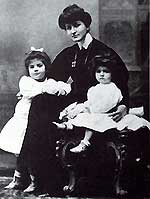
Alma and the two Mahler daughters |
None of these models held further meaning. Rather, Walter noted that while all Mahler's previous work grew out of his sense of life, his remaining work would be written in the shadow of death. Yet, although doomed, he wrote: "I am thirstier than ever for life," but on new terms: "At the end of my life, I must go back to living like a beginner and learn how to stand again." Thus he began a process of rediscovery and intense introspection.
The vehicle through which Mahler found new meaning in life was a book he had been given at some point following his crash, and that resonated deeply within his troubled soul. Mahler had always been enamored of German folk poetry, and had based most of his songs and several symphonic movements on settings of their texts, especially Das Knaben Wunderhorn ("The Youth's Magic Horn"). The new book was Hans Bethge's Die chinesische Flöte ("The Chinese Flute"). Alma claimed that he obtained it during that dreadful summer of 1907 as a gift from a friend of her father, but scholars have since pointed out that the volume was first published only that October. In any event, the book rekindled his creativity and by the next summer he plunged into a new work based on seven of its poems. Cooke notes that through the poems Mahler began a search for life on the threshold of death. He wrote Walter that he felt transformed, having found consolation in his music: "When I hear music I hear definite answers to all my questions and am wholly clear and sure." Noted Walter: "As twilight dissolves in the glow of sunset, the gloom his illness had cast upon his spirit passed into the radiance of approaching departure." Alma recalled that he slaved over his new work that summer without distraction; indeed the dates on the score indicate that the entire work was written within two months, and then orchestrated the following winter.
Mahler was deeply superstitious. He already had written eight symphonies, but was afraid to write a ninth. He was keenly aware that, of his illustrious predecessors, Beethoven never passed that number and Bruckner died trying. (Mahler's fears undoubtedly would have been worsened had he known that two other great symphonists, Schubert and Dvorak, fell victim to the same limit, but haphazard publication at the time overlooked some of their work and thus obscured that fact.) To alleviate his fear of succumbing as well, especially in light of his diagnosis, Mahler did not number his new work but rather subtitled it "A Symphony for Tenor, Contralto (or Baritone) and Orchestra." (Yet fate was not so easily fooled – thinking the danger had passed, Mahler titled his next work his Symphony # 9 and then died while composing its successor.)
Although The Chinese Flute purported to comprise authentic direct translations of the original poems, in fact Bethge knew no Chinese at all but rather "borrowed" his material from other intermediate sources, notably a 1905 collection by Hans B. Heitman, which itself was based on French translations by noted sinologists Judith Gautner and Herven Saint-Denis. In his massive study of Mahler's final years, Dennis Mitchell affords fascinating comparisons among literal translations of the Chinese source poems and the French, Heitman and Bethge versions (as well as Mahler's augmentation of the Heitmans for his music texts). Thus, the poem behind the fourth song originally ran to only nine short lines, St. Denis and Heitman provided eight increasingly more expansive ones, Bethge's version ran to 22 and Mahler's 32, each filling in ever greater detail and personality, adding natural imagery and defining the psychology, all of which are merely implied in the original.  Kurt Blaukopf notes that Bethge, himself a poet, infused his adaptations with cadences typical of his own work, and thus enhanced their suitability for musical settings. However, Mitchell notes that, unlike when Mahler set other poetry, here the music was dominant, as he often revised Bethge's wording to fit his musical inclinations, rather than molding the music to the existing text. Yet, Mitchell notes that despite all the revisions and romanticized touches that produced a Europeanized view, the essential oriental spirit remained largely intact. Kurt Blaukopf notes that Bethge, himself a poet, infused his adaptations with cadences typical of his own work, and thus enhanced their suitability for musical settings. However, Mitchell notes that, unlike when Mahler set other poetry, here the music was dominant, as he often revised Bethge's wording to fit his musical inclinations, rather than molding the music to the existing text. Yet, Mitchell notes that despite all the revisions and romanticized touches that produced a Europeanized view, the essential oriental spirit remained largely intact.
Despite his derivative sourcing, Bethge's postface to his volume provides fine historical background that helps explain its appeal to a Europe being swept by taste for the orient. He notes that surviving Chinese poetry is up to three millennia old, and thus ranks with Hebrew and Indian literature as the most ancient we still know. It preserves the original feeling since the Chinese language barely evolved, remained well known since Chinese culture reveres its ancient literature as a living art, and also reflected the national character since China was untainted by foreign influences. (Westernization and then the Revolution would change all that, of course.) The classical period peaked in the 8th Century with Li-Tao-Po (702 – 763), a vagabond and drunkard whose themes of pervasive melancholy, the transience of life, drinking to escape from earthly woes and seeking the mysteries of existence through natural symbols typify the Chinese outlook of vaunting lyricism over the epic or dramatic approaches of the West. (Although Li-Tao-Po is believed to have drowned while drunk, legend has it that the gods summoned him across the waters to dwell in eternity.) Bethge recalled that upon first encountering these poems, he "perceived a fragile, quasi-evanescent tenderness of lyrical sound, … a fully realized imaginative art in words that illuminated … the riddle of existence, … tremblingly delicate, … pregnant with symbolism, … flower-like in its graceful rendering of emotion." Apparently Mahler, too, was taken by their subtle power and found in them a means by which he was able to confront and sublimate his fate.
At first intended as a song cycle to be entitled "The Jade Flute," and then "The Song of Earth's Sorrow," Mahler's work evolved into the hour-long Das Lied von der Erde ("The Song of the Earth") comprising six movements that alternate tenor and contralto as vocal soloist:
- Das Trinklied vom Jammer der Erde ("The Drinking Song of the Earth's Sorrow") – after Li-Tao-Po, about 9 minutes in a typical performance – A celebration of wine to dispel doubts and fear, at least temporarily, as the thrusting energy of each verse subsides into "Dunkel ist das Leben, ist der Tod" ("Dark is life, is death"). After a comforting interlude, the central theme of the work emerges: the contrast between transitory lives and the permanence of nature, cemented by a striking image of a howling ape squatting on moonlit graves (which perhaps also suggests the futility of protesting the universal scheme).
- Der Einsame in Herbst ("The Lonely One in Autumn") – Tchang-Tsi, 9 minutes – A gentle, weary reflection upon the withering of life.
- Von der Jugend ("Of Youth") – Li-Tai-Po, 3 minutes – Happy youthful friends peacefully gather at a green porcelain pavilion and pool to drink and chat.
- Von der Schönheit ("Of Beauty") – Li-Tai-Po, 7 minutes – Girls gather lotus flowers by a river bank. The music explodes as lads trot by on horses and then recedes, as a girl yearns after them.
- Der Trukene im Frühling ("The Drunkard in Spring") – Li-Tai-Po, 5 minutes – Joy seems strained as the only way to bear the happiness of spring is to sleep drunkenly through it.
- Der Abschied ("The Farewell") – Mong-Koo-Yen and Wang-Wei (who were personal friends), 30 minutes – In the first of two complementary poems, as evening falls and nature comes to rest, a poet awaits an overdue friend to bid a final farewell. After a leisurely interlude, the friend arrives to say that he is traveling home for the last time. The final lines are by Mahler himself, ending the work on a deeply personal and indescribably moving note – a perfect blend of hope and resignation, of yearning and peace, of completion and renewal, of faith in eternity tinged by the knowledge that he soon would take his own leave:
Ich werde niemals in die Ferne schweifen,
Still ist mein Herz und harret seiner Stunde!
Die liebe Erde allüberall blüht auf in Lenz und grunt aufs neu!
Allüberall und ewig blauen Licht die Fernen!
Ewig … ewig …
I shall no longer seek the far horizon,
Still is my heart and awaits its hour!
The lovely earth everywhere blossoms and grows anew.
Everywhere and forever blue lights the horizon!
Forever … forever …
Such descriptions are woefully inadequate to suggest the exquisite beauty and efficiency of the words, their allusions to complex expressive truths beneath their shimmering realistic surface, the pervasive sadness of viewing life from afar. So, too, with Mahler's music, which Louis Biancolli aptly describes as always human and searching as both commentator and protagonist, speaking in an inspired stream of compelling self-revelation both personal and epochal, a clear extension of the scope of his prior symphonies, which he intended to embrace all aspects of life. Despite augmented forces, the orchestration is restrained, as if to reflect the sparse coloration of Chinese prints, while prominent use of gong, flute, mandolin, glockenspiel and ukulele hint at the Orient. It begins in swaggering confidence and at turns becomes wistful, frightening, delicate, snarling, sweet and even wryly humorous – a survey of the spirit and scope of life before the sober reflection and poignant searching of the finale. Michael Kennedy notes that while the music evolves with perpetual variation, it is unified by devices such as a falling second to signify yearning, and a rising minor third to evoke space and loneliness.
Blaukopf notes that, as a conductor, Mahler was intimately familiar with orchestral sound and concert-hall acoustics and, as an opera director, with the impact of flexible staging and unusual effects, all of which is evident throughout this most personal of his work. (Biancolli calls him a master anatomist, for whom the orchestra was a living organism.) Mitchell cites Mahler's fascination with the expressiveness of instruments playing at the extreme ends of their ranges to project a human quality of struggle. Thus, the first movement vocal part is written nearly an octave above a tenor's realm of comfort, including frequent fortissimo sustained a's and b-flats above the treble clef (for which the score helpfully provides alternative lower f-naturals), to ensure projection of the text's straining against life's troubles while the flutes' bizarre flutter-tonguing adds a touch of surreality. 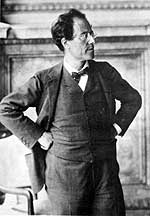 The runaway horse episode in the fourth movement ends with an unrelieved long string of forceful, rapid staccato notes, which the contralto either must break with an awkward breath or run short of wind, either way reflecting the physical exertion of the text. The runaway horse episode in the fourth movement ends with an unrelieved long string of forceful, rapid staccato notes, which the contralto either must break with an awkward breath or run short of wind, either way reflecting the physical exertion of the text.
Many commentators over the past century have grappled from a variety of perspectives with the novelty of Mahler's conception. Some seem fascinated by its melding of Chinese and Western outlooks. As summarized by Jonathan Kramer, Eastern philosophy views life as sparse and nature as a cycle of endless repetition, while a Western life is one of richness, dramatic confrontation and goal-oriented progress. Bethge added that the pervasive parallelism of Chinese thought is reflected even in the pictorial rhythm of its calligraphy.
Others hail Das Lied as an innovative hybrid between the two disparate musical elements of song and symphony. La Grange characterizes song as essentially intimate, lightly accompanied, dominated by voice, cast in strophic form, comprised of self-contained melodies barely transformed, and minimal growth, whereas the symphony is monumental, richly orchestrated, of more complex structure and of sophisticated development. To la Grange, the miracle of Das Lied is Mahler's combination of the two forms so that the essential integrity of each remains evident. Volker Scherleiss, though, notes that Mahler never treated song and symphony as distinct but rather as supplementary and complementary, with his songs conceived orchestrally and his symphonies suffused with vocal style, even without actual voices. Heard from that perspective, all his works combine intimacy and large expression, simple melody and complex thematic treatment.
Yet, several observers tend to liken Das Lied to a traditional symphony in which the first movement serves as the assertive opening, the second as the slow respite, the next three as a compound scherzo, and the finale as a weighty summation. Eric Blom goes further, spreading the middle three movements into a scherzo, a minuet and trio, and a rondo. Others, though, view it as having a psychological structure by which Mahler presents an exploration of life and where it all leads, perhaps as metaphoric autobiography. Thus, Biancolli sees a progression from open defiance of fate and life's vanities, through an exhausted wanderer's autumnal lament, backward glimpses at the vanished glory of youth, a desperate escape through drink from the futility of it all, and finally resignation and a calm farewell. Peter Branscombe finds the central question of existence posed at the outset, deferred in the central portion, and faced only at the end.
Indeed, many come to focus on the extraordinary finale which, by its sheer length and emotional weight, tends to balance, if not overshadow, all that precedes it. Especially alluring is its ineffably moving ending, in which Mahler bid farewell to the life he thought was over but to which he tenaciously clung, and in which he found solace in Nature as proof that he was destined to take his part in an eternal cycle of renewal. As the contralto repeatedly intones the word "ewig" ("forever") at the very bottom of her register, the first six iterations are in pairs, descending from e to d and d to c so as to nestle in the calm peace of C major. The last three words, though, are alone and drop only from e to d, where they remain unresolved and suspended, hovering a single degree above the tonic ground, waiting for a resolution that never comes. In Ernest Bloch's memorable phrase, it "melts with an unresolved suspension into an immeasurable forever." Or, as Walter noted: "While the world slowly melts away, he becomes the experience itself – a limitless range of feeling opens for he who soon will leave this earth." Mahler marks the end Gäzlich esterbend (completely dying away), yet his is a restless farewell – in the background, trombones, oboe, flute, celesta, harps, mandolin and strings flit by, varying the texture in repeated rhythmic fluctuations that suggest the oriental view of the continuity of life, perpetually changing yet somehow always the same. Clearly, Mahler was not about to go silently into the night. But rather than loudly protest his fate he internalized his emotion and affirmed his essential humanity as a guide for all who might follow.
Walter called Das Lied "Mahler's most personal work, perhaps the most personal work in music."  I've never heard it in concert, and frankly I never want to – it's far too personal and intimate, and thus ideally suited to recordings and the privacy they afford. Indeed, Mahler had told Walter that he feared Das Lied was too intense for an audience, and after completing the orchestration he stashed the score and never sought a performance. Walter led the premiere on November 11, 1911, six months after Mahler's death. In the introduction to his biography of Mahler, he wrote: "It was a heavy responsibility to take my great friend's place and introduce his work to the world." For the next 50 years, Walter served as his mentor's most fervent advocate, and his performances radiated incomparable authority. Upon leaving the Vienna Opera, Mahler had written to Walter: "I know of no one who understands me as well as I feel you do and I believe I have entered deep into the mine of your soul." Alma, too, credited Walter with a full understanding of her husband and wrote in her autobiography: "After [Mahler's] death, Walter's great and exalted art was at his service. He mastered its every subtlety … and he took the spirit of Mahler's work as the keystone of his own work as an interpretive musician." I've never heard it in concert, and frankly I never want to – it's far too personal and intimate, and thus ideally suited to recordings and the privacy they afford. Indeed, Mahler had told Walter that he feared Das Lied was too intense for an audience, and after completing the orchestration he stashed the score and never sought a performance. Walter led the premiere on November 11, 1911, six months after Mahler's death. In the introduction to his biography of Mahler, he wrote: "It was a heavy responsibility to take my great friend's place and introduce his work to the world." For the next 50 years, Walter served as his mentor's most fervent advocate, and his performances radiated incomparable authority. Upon leaving the Vienna Opera, Mahler had written to Walter: "I know of no one who understands me as well as I feel you do and I believe I have entered deep into the mine of your soul." Alma, too, credited Walter with a full understanding of her husband and wrote in her autobiography: "After [Mahler's] death, Walter's great and exalted art was at his service. He mastered its every subtlety … and he took the spirit of Mahler's work as the keystone of his own work as an interpretive musician."
The first recording of Das Lied was not made until May 24, 1936. Even then, the work apparently was deemed too obscure to risk the expense of studio sessions, and so its 14 sides were cut live at a Vienna Philharmonic concert to commemorate the 25th anniversary of Mahler's death. 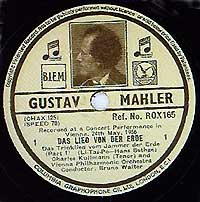 Suitably, Walter conducted. The result was an intensely human document, propelled by a marvelous feeling of spontaneity that eludes all other recordings. Orchestra and vocalists (tenor Charles Kullman and contralto Kerstin Thorberg) dig into their notes with wholehearted passion, often taking substantial liberty with the written rhythm; indeed, the scheme is set in the first movement, as the tenor often lags the orchestra, only to suddenly leap ahead, adding a vibrant touch of personality to his already heroic lines. Both singers project vast sincerity and even vulnerability by holding their vibrato to a minimum, and in the process avoid any suggestion of stylized opera or refined art singing. Even if the beginning is a bit scrappy, the orchestra, too, eschews the smooth sonic blend for which it was famed. While the somewhat crude recording obscures some of the detail and weakens the delicacy of the ending, the instrumental choirs compensate by standing out with vivid detail that highlights the inventiveness of Mahler's scoring. Although a relatively fleet 57 minutes, Walter's pacing never seems rushed, but rather vibrant and lucid. Among its glories are a Von der Schönheit that effortlessly integrates the heady drive of the galloping horses into the girls' wistful heartache. While we never will know how Mahler would have led Das Lied, and while Walter undoubtedly had matured and evolved over the quarter-century that had elapsed since he encountered the work with its composer, this first recording, even aside from its intrinsic splendor, boasts unique authenticity. Suitably, Walter conducted. The result was an intensely human document, propelled by a marvelous feeling of spontaneity that eludes all other recordings. Orchestra and vocalists (tenor Charles Kullman and contralto Kerstin Thorberg) dig into their notes with wholehearted passion, often taking substantial liberty with the written rhythm; indeed, the scheme is set in the first movement, as the tenor often lags the orchestra, only to suddenly leap ahead, adding a vibrant touch of personality to his already heroic lines. Both singers project vast sincerity and even vulnerability by holding their vibrato to a minimum, and in the process avoid any suggestion of stylized opera or refined art singing. Even if the beginning is a bit scrappy, the orchestra, too, eschews the smooth sonic blend for which it was famed. While the somewhat crude recording obscures some of the detail and weakens the delicacy of the ending, the instrumental choirs compensate by standing out with vivid detail that highlights the inventiveness of Mahler's scoring. Although a relatively fleet 57 minutes, Walter's pacing never seems rushed, but rather vibrant and lucid. Among its glories are a Von der Schönheit that effortlessly integrates the heady drive of the galloping horses into the girls' wistful heartache. While we never will know how Mahler would have led Das Lied, and while Walter undoubtedly had matured and evolved over the quarter-century that had elapsed since he encountered the work with its composer, this first recording, even aside from its intrinsic splendor, boasts unique authenticity.
The first of Walter's two studio recordings was made in 1952, also with the Vienna Philharmonic. While the timings of the movements are within seconds of 1936, the approaches are far different. Both the recording and playing are more beautiful, but lack the impulse and sheer character that made the concert so exciting. 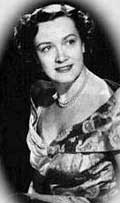 Yet, extraordinary poignancy is added by contralto Kathleen Ferrier, who was fatally ill at the time and thus invested her part, and especially the final farewell, with an exceptional degree of personal identification. While some have faulted her technique (both apparatus and control) at the end of her career, Walter himself called their collaboration "one of the most significant encounters of my artistic life." Indeed, she is the only artist to whom he gives more than a passing mention in his biography of Mahler. There he said: Yet, extraordinary poignancy is added by contralto Kathleen Ferrier, who was fatally ill at the time and thus invested her part, and especially the final farewell, with an exceptional degree of personal identification. While some have faulted her technique (both apparatus and control) at the end of her career, Walter himself called their collaboration "one of the most significant encounters of my artistic life." Indeed, she is the only artist to whom he gives more than a passing mention in his biography of Mahler. There he said:
Her performance remains among the deepest and happiest experiences of my musical life. The lovely timbre of her voice moved me, when I first heard it, as hardly any other sound ever has. And she had a soul as well as a voice. That soul knew and resounded the very soul of Mahler. I have often thought how much it would have meant to him to hear the profound understanding in her performances. She expressed intense feeling over the gamut from charm to tragedy. To Mahler she rendered a permanent service that lives on in her recording.
Although there's undeniable poignancy in her struggle for control as her life slipped away at the height of her career, frankly I don't quite hear it on record, but who am I to argue with Walter? And in any event, this recording has been cited more often than any other as the greatest Das Lied of all. Even so, I find more sheer passion in the several Walter concerts that have become available, of which perhaps the most exciting is a February 22, 1953 event with the New York Philharmonic, Elena Nicolaidi and Set Svanholm (AS Disc), which recaptures much of the impulsive thrill from 1936.
Having suffered a heart attack and facing his own mortality, Walter produced a gorgeous stereo remake in 1960 (Sony CD).  Paced at a far slower 63 minutes, much of the former drive is left behind while maintaining a full-blooded depth and richness. Throughout, it radiates extraordinary sheen and polish by the New York Philharmonic, Ernst Hafliger and especially Mildred Miller, whose wondrous voice effortlessly flits among the silvery light and variegated shade that seems ideal for this music. The sheer beauty of the performance arises from dignity and confidence rather than any lack of spirituality, as if Walter, like his mentor, sought to affirm his life by summoning and distilling his art into an enduring personal retrospective statement. Like his vastly different 1936 concert, Walter's final recording is a unique achievement. Paced at a far slower 63 minutes, much of the former drive is left behind while maintaining a full-blooded depth and richness. Throughout, it radiates extraordinary sheen and polish by the New York Philharmonic, Ernst Hafliger and especially Mildred Miller, whose wondrous voice effortlessly flits among the silvery light and variegated shade that seems ideal for this music. The sheer beauty of the performance arises from dignity and confidence rather than any lack of spirituality, as if Walter, like his mentor, sought to affirm his life by summoning and distilling his art into an enduring personal retrospective statement. Like his vastly different 1936 concert, Walter's final recording is a unique achievement.
Walter's 1952 venture was the second studio recording of Das Lied, preceded the prior year by Otto Klemperer and the Vienna Symphony Orchestra with Elsa Caveti and Anton Dermota on a Vox LP. 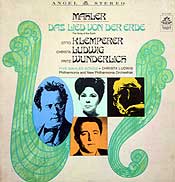 Klemperer was second only to Walter as an apostle of Mahler, who was so impressed that he launched Klemperer's career as a conductor with a rare glowing testimonial. Klemperer's Vox recording is visceral, headstrong and fleet, as though to disclaim others' feeling of introspection, resignation and ineffable sadness – all the more remarkable in contrast to his 1967 stereo remake with the Philharmonia (EMI). Cast in the basic mold of Walter's autumnal recording (64 minutes vs. 51 on Vox), Klemperer's steady demeanor is offset by incisive detail and sharp inflection from which the felicities of the orchestration emerge earnestly. The glorious vocalists are Fritz Wunderlich, who leaps over the drunkard's vocal hurdles with masculine grace, languishes alongside the youthful revelers and rails at the world's foibles through the fog of drunken oblivion, and Christa Ludwig, whose deep but magnificently controlled power aches with timeless yearning. The overall impact is one of a distant observer of the world and its foibles, suffused with calm. The end of both recordings is disquieting – rather than the accustomed gradual fade into silence following the final powerful affirmation of vitality, contralto and orchestra maintain much of their volume through the last notes, refusing to let go until the last moment, as though clinging to the last shreds of evaporating life, enduring until forced to a reluctant halt. Klemperer was second only to Walter as an apostle of Mahler, who was so impressed that he launched Klemperer's career as a conductor with a rare glowing testimonial. Klemperer's Vox recording is visceral, headstrong and fleet, as though to disclaim others' feeling of introspection, resignation and ineffable sadness – all the more remarkable in contrast to his 1967 stereo remake with the Philharmonia (EMI). Cast in the basic mold of Walter's autumnal recording (64 minutes vs. 51 on Vox), Klemperer's steady demeanor is offset by incisive detail and sharp inflection from which the felicities of the orchestration emerge earnestly. The glorious vocalists are Fritz Wunderlich, who leaps over the drunkard's vocal hurdles with masculine grace, languishes alongside the youthful revelers and rails at the world's foibles through the fog of drunken oblivion, and Christa Ludwig, whose deep but magnificently controlled power aches with timeless yearning. The overall impact is one of a distant observer of the world and its foibles, suffused with calm. The end of both recordings is disquieting – rather than the accustomed gradual fade into silence following the final powerful affirmation of vitality, contralto and orchestra maintain much of their volume through the last notes, refusing to let go until the last moment, as though clinging to the last shreds of evaporating life, enduring until forced to a reluctant halt.
The subtitle to Das Lied specifies performance by tenor and "contralto (or baritone)." 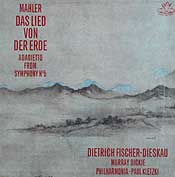 While the vast majority of recordings opt for a contralto, several present the male alternative. The first was by Murray Dickie, Dietrich Fischer-Dieskau and the Philharmonia conducted by Paul Kletzki (1960, EMI). Largely forgotten nowadays, Kletzki was admired in his time for Mahler with expressive risk-taking in the tradition of his mentor, Wilhelm Furtwangler. Thus, the galloping horse episode in the fourth movement is sparked by a sudden leap to a breathless pace, slashing violin figures, a grand pause before the return to tranquility and mandolin chords so prominent as to sound amplified, all underlining a bold burst of freedom within an otherwise highly restrained stylization. In lieu of the gender distinction between odd- and even-numbered movements, Kletzki relies on the contrast between the strikingly different textures of Murray's ardent, cutting high tenor and Fischer-Dieskau's confident, mellow repose. A more recent version from Simon Rattle and the Birmingham Symphony (1995, EMI) culminates in a meltingly lovely touch as the baritone voice of Thomas Hampson slowly fades into the instrumental void, secure and calm within its natural register, perhaps symbolizing man willingly returning to dust and joining the eternal cycle of Nature. While the vast majority of recordings opt for a contralto, several present the male alternative. The first was by Murray Dickie, Dietrich Fischer-Dieskau and the Philharmonia conducted by Paul Kletzki (1960, EMI). Largely forgotten nowadays, Kletzki was admired in his time for Mahler with expressive risk-taking in the tradition of his mentor, Wilhelm Furtwangler. Thus, the galloping horse episode in the fourth movement is sparked by a sudden leap to a breathless pace, slashing violin figures, a grand pause before the return to tranquility and mandolin chords so prominent as to sound amplified, all underlining a bold burst of freedom within an otherwise highly restrained stylization. In lieu of the gender distinction between odd- and even-numbered movements, Kletzki relies on the contrast between the strikingly different textures of Murray's ardent, cutting high tenor and Fischer-Dieskau's confident, mellow repose. A more recent version from Simon Rattle and the Birmingham Symphony (1995, EMI) culminates in a meltingly lovely touch as the baritone voice of Thomas Hampson slowly fades into the instrumental void, secure and calm within its natural register, perhaps symbolizing man willingly returning to dust and joining the eternal cycle of Nature.
The most renown of the all-male recordings was led by Leonard Bernstein, in one of the three projects he undertook in Vienna for Decca in 1966 (along with an LP of Mozart and a complete Falstaff). All the performers are exquisitely sensitive to nuances of texture and expression. Fischer-Dieskau again brings to his role the polished taste and sensibility gained from years of famed lieder recitals of Schubert and others of the German/Austrian mold. The Vienna Philharmonic, too, is vividly alive, speaking with a lilting Viennese accent that places Mahler firmly in the same tradition. The variant of using only male voices changes the emotional impact. On the one hand, Mahler seems to be speaking directly through a performer of his own gender. Yet, something powerful is lost – the vision of earth as a welcoming mother, an image that had deep personal significance for Mahler, which he had mentioned as early as in an 1879 letter to a friend in which he viewed death as becoming united with the earth, and which was confirmed in a single 1910 analysis session with Sigmund Freud, who diagnosed a mother fixation. in one of the three projects he undertook in Vienna for Decca in 1966 (along with an LP of Mozart and a complete Falstaff). All the performers are exquisitely sensitive to nuances of texture and expression. Fischer-Dieskau again brings to his role the polished taste and sensibility gained from years of famed lieder recitals of Schubert and others of the German/Austrian mold. The Vienna Philharmonic, too, is vividly alive, speaking with a lilting Viennese accent that places Mahler firmly in the same tradition. The variant of using only male voices changes the emotional impact. On the one hand, Mahler seems to be speaking directly through a performer of his own gender. Yet, something powerful is lost – the vision of earth as a welcoming mother, an image that had deep personal significance for Mahler, which he had mentioned as early as in an 1879 letter to a friend in which he viewed death as becoming united with the earth, and which was confirmed in a single 1910 analysis session with Sigmund Freud, who diagnosed a mother fixation.
Das Lied was the only work omitted from Bernstein's Mahler symphony cycle with the New York Philharmonic (and the London Symphony for the Symphony # 8) that he recorded throughout the 1960s for Columbia, with which he had an exclusive contract and from which the Decca sessions were the only exception. 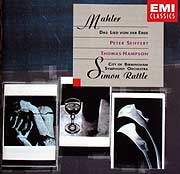 He completed his Columbia cycle with a new Das Lied in 1972 that seems more motivated by marketing than artistic reasons – it's strikingly similar to the 1966 version in concept, but the Israel Philharmonic can't match the nuances and polish of their Vienna counterpart, and indeed seems a bit ragged in comparison, with rhythmic imprecision and awkward balances. Ludwig, too, sounding matronly and operatic, pales beside her magnificent recording with Klemperer. He completed his Columbia cycle with a new Das Lied in 1972 that seems more motivated by marketing than artistic reasons – it's strikingly similar to the 1966 version in concept, but the Israel Philharmonic can't match the nuances and polish of their Vienna counterpart, and indeed seems a bit ragged in comparison, with rhythmic imprecision and awkward balances. Ludwig, too, sounding matronly and operatic, pales beside her magnificent recording with Klemperer.
While Bernstein's 66½ minute Vienna Das Lied attracted attention at the time as the most deliberately paced, it was superceded for that dubious distinction by a widely acclaimed 1972 concert with the BBC Northern Symphony Orchestra, Alfreda Hodgson and John Mitchenson led by Jascha Horenstein (BBC and many other labels) that weighed in at over 69. Admittedly, the expanded tempos expressively integrate the six otherwise disparate movements and perhaps suggest the overall continuity of the process of life, even though the inertia tends to make much of the detail sound like isolated events. Yet, the emotional range is so compressed and the visceral outbursts so attenuated that vitality seems a distant afterthought; without energy to dissipate and deplete, the conclusion substitutes a gentle departure for the wrenching complexity of Mahler's emotions. 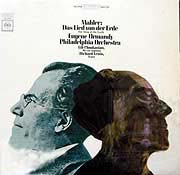 Despite a bright sonority, the first movement begins at a funereal pace and lacks the sting of the text, while the fifth seems a mere poetic reflection rather than a swaggering drunken rant. Yet, the performance does serve to raise a profound philosophical question – does true appreciation of life demand living to the fullest? Despite a bright sonority, the first movement begins at a funereal pace and lacks the sting of the text, while the fifth seems a mere poetic reflection rather than a swaggering drunken rant. Yet, the performance does serve to raise a profound philosophical question – does true appreciation of life demand living to the fullest?
Most other neutral accounts avoid distending the duration. A fine rendition was given by Eugene Ormandy and the Philadelphia Orchestra in 1966 (Sony). Both were Mahler pioneers – the orchestra (led by Leopold Stokowski) gave the American premiere of Das Lied in 1916, Ormandy cut the first electrical recording of the Mahler "Resurrection" Symphony in 1934, and both made the first recording of a completion of the Mahler Tenth (in the Deryk Cooke edition) in 1964. Richard Lewis's fervor and Lili Chookasian's world-weary calm portray the two extremes of the human condition, nestled within a rich, confident and self-effacing orchestral fabric, with a few individual but appropriate touches, as when the final sting of the first movement echoes rather than sounds abruptly.
Of other generally objective accounts,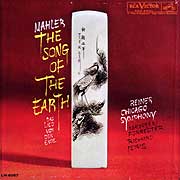 Fritz Reiner's 1962 Chicago Symphony recording with Maureen Forrester and Richard Lewis is far more inflected than the conductor's usual approach to the late Romantic repertoire, while still benefiting from his usual attention to detail and balance. Yet, the original LP set perhaps was most notable for its packaging with a rather bland rendition of Haydn's Symphony # 88, which the notes rationalized as showing how far the Viennese symphony had evolved from logic, elegance and balanced design to freedom and flexibility: "An exuberant extrovert is replaced by an agitated introvert, classical objectivity has yielded to turbulent individualism." True enough, but Reiner's (and many others') straightforward approach merely conveys the surface content and leaves a shallow impression. There's more to a great Mahler performance (and Haydn!) than just accurately playing the notes. Fritz Reiner's 1962 Chicago Symphony recording with Maureen Forrester and Richard Lewis is far more inflected than the conductor's usual approach to the late Romantic repertoire, while still benefiting from his usual attention to detail and balance. Yet, the original LP set perhaps was most notable for its packaging with a rather bland rendition of Haydn's Symphony # 88, which the notes rationalized as showing how far the Viennese symphony had evolved from logic, elegance and balanced design to freedom and flexibility: "An exuberant extrovert is replaced by an agitated introvert, classical objectivity has yielded to turbulent individualism." True enough, but Reiner's (and many others') straightforward approach merely conveys the surface content and leaves a shallow impression. There's more to a great Mahler performance (and Haydn!) than just accurately playing the notes.
A more effective type of neutral approach comes from the Cleveland Orchestra led by Pierre Boulez (1999, DG), whose modernist outlook seeks to scrub the score clean of interpretive rhetoric. Yet, while the orchestral sections emerge with sparking clarity, clean textures, alluring grace and rhythmic élan that even lightens the sobriety of the last movement interlude, the soloists tend to deliver their lines conventionally, from a spirited beginning to the wistful conclusion. While the result surely tends to lessen the philosophical overtones, it adds a layer of poignancy, as if to emphasize the sorrow of depriving such energetic and youthful figures of further life. It also shifts the human element from the instruments to the singers, who tend to bear the full, albeit diminished, emotional weight of the piece. Indeed, the ravishing voice and calm demeanor of contralto Violetta Urmana makes her three songs especially moving. Combined with the light texture, her final farewell is utterly heartrending. whose modernist outlook seeks to scrub the score clean of interpretive rhetoric. Yet, while the orchestral sections emerge with sparking clarity, clean textures, alluring grace and rhythmic élan that even lightens the sobriety of the last movement interlude, the soloists tend to deliver their lines conventionally, from a spirited beginning to the wistful conclusion. While the result surely tends to lessen the philosophical overtones, it adds a layer of poignancy, as if to emphasize the sorrow of depriving such energetic and youthful figures of further life. It also shifts the human element from the instruments to the singers, who tend to bear the full, albeit diminished, emotional weight of the piece. Indeed, the ravishing voice and calm demeanor of contralto Violetta Urmana makes her three songs especially moving. Combined with the light texture, her final farewell is utterly heartrending.
According to Jonathan Carr, as he had done for all his prior song cycles Mahler wrote Das Lied simultaneously in two versions – the one generally performed with full orchestral accompaniment and another for piano. 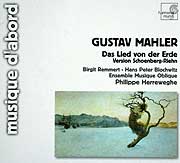 While perhaps intended as a practical necessity for home performance, the piano's intimacy cannot compensate for the loss of textural variation so essential to Mahler's conception. A fascinating compromise is presented in a chamber transcription by Arnold Schoenberg. (Despite his forbidding avant-garde reputation, Schoenberg had wide respect for most music in the Austrian tradition, and even arranged numerous Strauss waltzes.) The notes to a fine recording by Birgit Remmert, Hans Peter Blochwitz and the Ensemble Musique Oblique led by Phillippe Herreweghe (1994, Harmonia Mundi) analogize the result to "bonsai" (the Japanese art of growing miniature trees that exhibit the characteristics of full-size mature specimens) – a reduction to and concentration of essence to "render a service to the lines and legibility [to avoid] disintegration" of the timbres of the full orchestra. In all candor, that seems more than a bit presumptuous – surely if Mahler, a master orchestrator, had wanted to thin his textures he would have done so himself. Writing in Fanfare, Raymond Tuttle offers a more likely reason – in the days before electrical recording, this was a reasonable way to perform works of limited appeal without the expense of hiring a full assortment of musicians. Thus, Schoenberg had co-founded a Viennese Society for Private Musical Performances but left his transcription of Das Lied unfinished after the demise of the organization in 1920, to be completed in 1983 by Rainer Riehn. The result is an intriguing historical marker whose impact is severely diminished not only during climaxes but in an overall lack of depth and tonal variety. The uniformity of texture can't sustain the length of the work, especially the half-hour finale. Even the intimate moments lose, not only in contrast to the surrounding outbursts but also in lowering the tension of repressing the force of a full orchestra. While perhaps intended as a practical necessity for home performance, the piano's intimacy cannot compensate for the loss of textural variation so essential to Mahler's conception. A fascinating compromise is presented in a chamber transcription by Arnold Schoenberg. (Despite his forbidding avant-garde reputation, Schoenberg had wide respect for most music in the Austrian tradition, and even arranged numerous Strauss waltzes.) The notes to a fine recording by Birgit Remmert, Hans Peter Blochwitz and the Ensemble Musique Oblique led by Phillippe Herreweghe (1994, Harmonia Mundi) analogize the result to "bonsai" (the Japanese art of growing miniature trees that exhibit the characteristics of full-size mature specimens) – a reduction to and concentration of essence to "render a service to the lines and legibility [to avoid] disintegration" of the timbres of the full orchestra. In all candor, that seems more than a bit presumptuous – surely if Mahler, a master orchestrator, had wanted to thin his textures he would have done so himself. Writing in Fanfare, Raymond Tuttle offers a more likely reason – in the days before electrical recording, this was a reasonable way to perform works of limited appeal without the expense of hiring a full assortment of musicians. Thus, Schoenberg had co-founded a Viennese Society for Private Musical Performances but left his transcription of Das Lied unfinished after the demise of the organization in 1920, to be completed in 1983 by Rainer Riehn. The result is an intriguing historical marker whose impact is severely diminished not only during climaxes but in an overall lack of depth and tonal variety. The uniformity of texture can't sustain the length of the work, especially the half-hour finale. Even the intimate moments lose, not only in contrast to the surrounding outbursts but also in lowering the tension of repressing the force of a full orchestra.
Aside from listening, of course (and following the orchestral score – the first Universal Edition of 1912 was republished by Dover in 1988), my primary sources of information for this piece were the following:
- Bruno Walter: Gustav Mahler (Knopf, 1938, reprinted with an expanded introduction, 1957) – Predictably gushing with praise, this slim biography by Mahler's foremost protégé is poetic and heartfelt and contains some nice insights into the music Walter knew so well.
- Alma Mahler: Gustav Mahler – Memories and Letters (John Murray, Ltd, 1940) – Mahler's widow provides first-hand recollection of their relationship during the key period for Das Lied. There's disappointingly little mention of the music and, as many have since pointed out, her memory is replete with inaccuracy.
- Donald Mitchell: Gustav Mahler, Volume III – Songs and Symphonies of Life and Death (University of California, 1985) – The conclusion of Mitchell's massive study of Mahler's work presents source materials (including the Chinese calligraphy of each poem, all the translations Mahler and Bethge relied upon, and the wonderful postface to Bethge's book)
 plus an extraordinarily detailed analysis of the interrelationship of Das Lied's texts, structures, themes and textures. His treatment of the finale alone runs to 120 pages of text and footnotes. plus an extraordinarily detailed analysis of the interrelationship of Das Lied's texts, structures, themes and textures. His treatment of the finale alone runs to 120 pages of text and footnotes.
- Henri Louis de la Grange: Gustav Mahler (Oxford, 1999) – Another massive 3-volume biography loaded with insight. I cheated, though, relying instead on the many sets of liner notes la Grange provided for Das Lied LPs and CDs.
- Michael Kennedy: Mahler (J. M. Dent, 1974); Kurt Blaukopf: Mahler (Praeger, 1973); Deryk Cooke: Gustav Mahler – An Introduction to His Music (Cambridge University, 1980); Jonathan Carr: Mahler – A Biography (Overlook Press, 1998) – All good biographies with basic background information.
- Henry A. Lea: Gustav Mahler – Man on the Margin (Bouvier Verlag, 1985) – As the subtitle implies, a study of the intense social pressures that led Mahler to create such far-reaching and precariously balanced music.
- James Lyons' notes to the London Bernstein LP; Volker Scherliess's notes to the Bernstein Sony CD, and especially Louis Biancolli's brilliant notes to the Reiner LP.
- Theodor Adorno: Mahler – A Musical Physiognomy (University of Chicago, 1992) – I couldn't directly use any of this dense and often baffling book, but it's by far the most challenging Mahler appreciation I've ever encountered. A short sample, a propos of Der Abschied: "What is beyond form is akin through form to the still formless; the parousias of the supernatural, in which an excess of meaning is discharged, are composed of fragments of the natural bereft of meaning." Got that?

Copyright 2007 by Peter Gutmann
|
